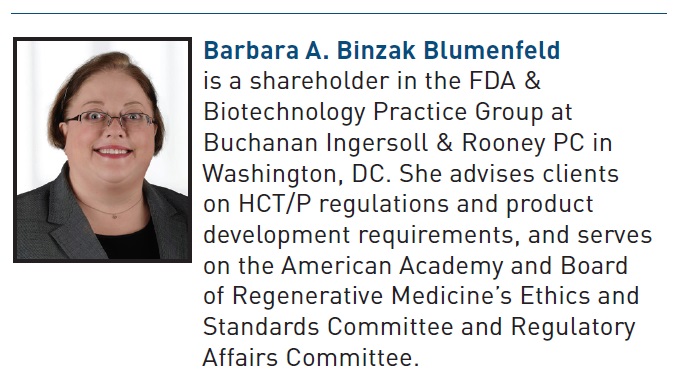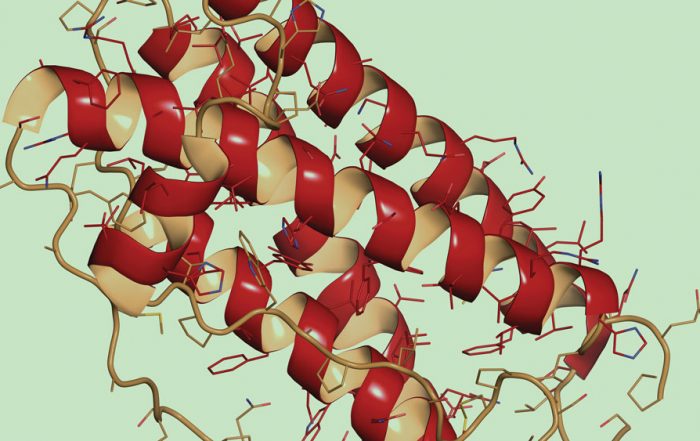
FDA Sharpens its Focus on Regenerative Medicine Regulation
Renewed agency activity has altered the regenerative medicine landscape. Barbara A. Binzak Blumenfeld (Buchanan Ingersoll & Rooney) provides an overview of recent advances in FDA’s approach to regulating human cells, tissues, and cellular tissue-based products (HCT/Ps) and provides a glimpse into FDA’s next steps for regulation and enforcement.
FDA Sharpens its Focus on Regenerative Medicine Regulation
by Barbara A. Binzak Blumenfeld
The last 12 months have proven to be extremely active ones for the U.S. Food and Drug Administration’s (FDA) regulation of cell- and tissue-based products. FDA’s historical approach for regulating human cells, tissues, and cellular and tissue-based products (HCT/Ps) was characterized by periods of activity, such as the release of new regulations, followed by long periods of agency silence on its implementation of such regulations. However, FDA’s efforts since late 2014–and particularly since fall 2016–have arguably been more sustained and responsive to public input than ever before. The agency has engaged stakeholders on the scientific, medical, and regulatory challenges posed by these therapies; reorganized the Center for Biologics Evaluation and Research (CBER); awarded the first regenerative medicine advanced therapy (RMAT) designations; and published about the risks and benefits of HCT/Ps in the popular scientific literature. Moreover, with the FDA Commissioner’s recent preview of a new regenerative medicine regulatory paradigm expected to be announced in September, FDA shows no signs of slowing down its efforts to regulate these therapies.
HCT/P Basics
 FDA’s current HCT/P regulatory approach is based on the risk a recipient faces by receiving a cell or tissue therapy. On one end of the spectrum are low-risk HCT/Ps.1 These products meet one of six regulatory exceptions and are the subject of little FDA oversight. On the other end of the spectrum are high-risk HCT/Ps, known as “351 HCT/Ps.”2 These products require full approval as new drugs, biologics, and/or medical devices under Public Health Service Act (PHS Act) § 351 and/or the Federal Food, Drug, and Cosmetic Act (FDCA). These high-risk products must also comply with FDA’s 21 C.F.R. Part 1271 HCT/P regulations as well.products must also comply with FDA’s 21 C.F.R. Part 1271 HCT/P regulations as well.
FDA’s current HCT/P regulatory approach is based on the risk a recipient faces by receiving a cell or tissue therapy. On one end of the spectrum are low-risk HCT/Ps.1 These products meet one of six regulatory exceptions and are the subject of little FDA oversight. On the other end of the spectrum are high-risk HCT/Ps, known as “351 HCT/Ps.”2 These products require full approval as new drugs, biologics, and/or medical devices under Public Health Service Act (PHS Act) § 351 and/or the Federal Food, Drug, and Cosmetic Act (FDCA). These high-risk products must also comply with FDA’s 21 C.F.R. Part 1271 HCT/P regulations as well.products must also comply with FDA’s 21 C.F.R. Part 1271 HCT/P regulations as well.
Between these two extremes lies a heretofore vast middle ground of HCT/Ps considered to pose “moderate-risk” to recipients. These HCT/Ps are regulated under PHS Act § 361 and Part 1271, and are typically referred to as “361 HCT/Ps.”3 It is this category of products that has caused the most confusion among stakeholders and the biggest challenges for the agency. As a result, FDA issued four draft guidance documents4 between October 2014 and October 2015 to clarify its criteria for each category. FDA extended the comment deadline on these four documents by almost five months because of the intense interest they garnered.5
FDA’s Busy Year
After postponing a two-day public hearing originally scheduled for April 2016 due to the overwhelming response to attend,6 FDA held three public meetings over the course of four days in September 2016 to discuss the scientific, medical, and regulatory issues associated with HCT/Ps. These sessions included a one-day public meeting of the Cellular, Tissue, and Gene Therapies Advisory Committee,7 a one-day public workshop on the development of scientific evidence for 351 HCT/Ps,8 and a two-day public hearing on the four HCT/P draft guidance documents.9 FDA’s devotion of four days in a single month to the topic of HCT/Ps portended the agency activity that was yet to come in 2016 and the first half of 2017.
One month after these meetings, FDA announced in October 2016 that it had restructured CBER “to more efficiently accomplish its regulatory mission.”10 Among other changes, FDA renamed the Office of Cellular, Tissue and Gene Therapies as the Office of Tissues and Advanced Therapies (OTAT), in the process adding regulatory authority over purified and recombinant hematological therapeutic proteins and antivenins to OTAT. OTAT is now also responsible for determining whether applicants for the RMAT designation11 meet the criteria established in the 21st Century Cures Act.12 Pursuant to this new RMAT designation, a regenerative medicine drug may be eligible for accelerated approval if it:
(1) Is a “regenerative medicine therapy,” defined as a cell therapy, therapeutic tissue engineering product, human cell and tissue product, or any combination product including one of these therapies or products, except for 361 HCT/Ps;
(2) Is intended to treat, modify, reverse, or cure a life-threatening or serious disease or condition; and
(3) Has existing preliminary clinical evidence indicating that it may meet an unmet medical need for a disease or condition.
So far, FDA has received almost two dozen RMAT designation requests, and four companies have received the designation.13
Despite these noted developments, FDA published a cautionary article on the benefits and risks of stem cell therapies in the New England Journal of Medicine in November 2016.14 The article, co-authored by then-FDA Commissioner Dr. Robert Califf, made clear that the agency would work with sponsors to approve therapies in a manner that would not sacrifice the need to demonstrate both safety and efficacy. FDA noted that “[t]he literature is replete with instances of therapeutic interventions pursued on the basis of expert opinion and patient acceptance that ultimately proved ineffective or harmful when studied in well-controlled trials comparing them with the standard of care.” These words became more prescient when the NEJM reprinted the agency’s article in March 201715 alongside two medical articles highlighting very different outcomes for autologous stem cell treatments.16
Most recently, FDA Commissioner Scott Gottlieb previewed a potentially seismic shift in FDA’s approach towards regulation of regenerative medicine therapies.17 Noting that CBER’s OTAT is implementing the RMAT designation, Dr. Gottlieb stated that FDA will announce a “comprehensive framework for the development and proper FDA oversight of regenerative medicine” in September 2017 as part of the agency’s Innovation Initiative. According to the Commissioner, FDA’s efforts will be comprised of new guidance documents, “policies for appropriate and efficient regulatory oversight” of such products, and the creation of “an accessible framework that will enable providers to more easily collaborate on proving these principles for regenerative medicine products that are advanced within local medical institutions.”
FDA’s Next Steps
Several conclusions can be drawn from the agency’s activities during the past year. FDA has demonstrated its openness to learning more about stakeholders’ views on regenerative medicine to inform the agency’s continued evolution and enforcement of the HCT/P regulatory paradigm. In addition, the agency will use the new RMAT designation, as well as FDA’s previously-defined accelerated approval pathways, to streamline regenerative medicine therapy approvals without sacrificing the bedrock principle that new therapies must be both safe and effective.
What is not at all clear is what the new September regenerative medicine framework will mean for industry, academicians, physicians, and waiting patients. Will FDA retain the HCT/P framework outlined in its Part 1271 regulations? Will FDA revise its four existing HCT/P draft guidance documents, or will it abandon them and issue new ones? How exactly will the agency implement its “comprehensive” regulatory framework for these products? Will FDA’s efforts encompass both cell and tissue products as well as gene therapy treatments? The Commissioner’s telling references to “proper,” “appropriate,” and “efficient” regulation of regenerative medicine therapies suggests that we might expect significant changes to the current HCT/P framework–or at least how it is implemented.
As active as FDA’s past year has been, we should expect even more activity on these regenerative medicine issues in the coming months. FDA has been listening to stakeholders, and the agency now appears on the verge of executing the next phase of its regulatory plan.
- 21 C.F.R. § 1271.15.
- 21 C.F.R. § 1271.20.
- 21 C.F.R. § 1271.10.
- 79 Fed. Reg. 63448 (October 23, 2014) (same surgical procedure draft guidance); 79 Fed. Reg. 77012 (minimal manipulation draft guidance); 79 Fed. Reg. 77414 (adipose tissue draft guidance); 80 Fed. Reg. 66850 (October 30, 2015) (homologous use draft guidance).
- 81 Fed. Reg. 23664 (April 22, 2016).
- 81 Fed. Reg. 23661 (April 22, 2016).
- 81 Fed. Reg. 51917 (August 5, 2016); 2016 Meeting Materials, Cellular, Tissue and Gene Therapies Advisory Committee (last updated November 23, 2016), https://www.fda.gov/AdvisoryCommittees/CommitteesMeetingMaterials/BloodVaccinesandOtherBiologics/CellularTissueandGeneTherapiesAdvisoryCommittee/ucm482549.htm.
- 81 Fed. Reg. 23708 (April 22, 2016); Public Workshop: Scientific Evidence in the Development of Human Cells, Tissues, and Cellular and Tissue-Based Products Subject to Premarket Approval (last updated November 21, 2016), https://www.fda.gov/BiologicsBloodVaccines/NewsEvents/WorkshopsMeetingsConferences/ucm492499.htm.
- 81 Fed. Reg. 23661 (April 22, 2016); Public Hearing; Request for Comments – Draft Guidances Relating to the Regulation of Human Cells, Tissues or Cellular or Tissue-Based Products (last updated December 9, 2016), https://www.fda.gov/BiologicsBloodVaccines/NewsEvents/WorkshopsMeetingsConferences/ucm462125.htm.
- Information on CBER Restructuring (last updated October 19, 2016), https://www.fda.gov/AboutFDA/CentersOffices/OfficeofMedicalProductsandTobacco/CBER/ucm525907.htm.
- Regenerative Medicine Advanced Therapy Designation (last updated March 13, 2017), https://www.fda.gov/biologicsbloodvaccines/cellulargenetherapyproducts/ucm537670.htm.
- Sec. 3033 of Pub. Law No. 114-255 (December 13, 2016).
- Gottlieb, S. How FDA Plans to Help Consumers Capitalize on Advances in Science (posted July 7, 2017), https://blogs.fda.gov/fdavoice/index.php/2017/07/how-fda-plans-to-help-consumers-capitalize-on-advances-in-science/; Humacyte Receives FDA Regenerative Medicine Advanced Therapy (RMAT) Expedited Review Designation for HUMACYL® in Vascular Access for Hemodialysis (March 20, 2017), http://www.humacyte.com/press/humacyte-receives-fda-regenerative-medicine-advanced-therapy-rmat-expedited-review-designation-humacyl-vascular-access-hemodialysis/; Enzyvant Receives FDA Breakthrough Therapy Designation and Regenerative Medicine Advanced Therapy Designation for Investigational Therapy RVT-802 (April 17, 2017), http://www.prnewswire.com/news-releases/enzyvant-receives-fda-breakthrough-therapy-designation-and-regenerative-medicine-advanced-therapy-designation-for-investigational-therapy-rvt-802-300440401.html?tc=eml_cleartime; jCyte Receives Regenerative Medicine Advanced Therapy Designation (May 2, 2017), http://jcyte.com/2017/05/jcyte-receives-regenerative-medicine-advanced-therapy-designation/; Vericel Receives FDA Regenerative Medicine Advanced Therapy (RMAT) Designation for Ixmyelocel-T for the Treatment of Advanced Heart Failure Due to Ischemic Dilated Cardiomyopathy (May 10, 2017), http://investors.vcel.com/releasedetail.cfm?releaseid=1025739.
- Marks, P.W., Witten, C.M., and Califf, R.M. Clarifying Stem-Cell Therapy’s Benefits and Risks. Published online (November 30, 2016) at www.NEJM.org.
- Marks, P.W., Witten, C.M., and Califf, R.M. Clarifying Stem-Cell Therapy’s Benefits and Risks. N. Engl. J. Med. 376:1007-1009 (March 16, 2017).
- Mandai, M. et al. Autologous Induced Stem-Cell-Derived Retinal Cells for Macular Degeneration. N. Engl. J. Med. 376:1038-1046 (March 16, 2017); Kuriyan, A.E. et al. Vision Loss after Intravitreal Injection of Autologous “Stem Cells” for AMD. N. Engl. J Med. 376:1047-1053 (March 16, 2017).
- Gottlieb, S. How FDA Plans to Help Consumers Capitalize on Advances in Science (posted July 7, 2017), https://blogs.fda.gov/fdavoice/index.php/2017/07/how-fda-plans-to-help-consumers-capitalize-on-advances-in-science/.
Update Magazine
July/August 2017









